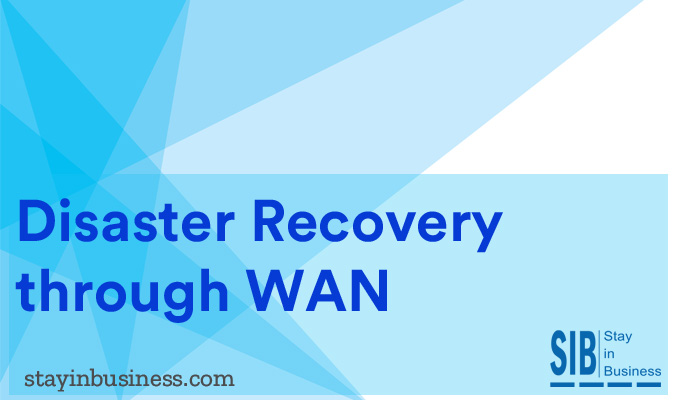
The role of corporate networks during a business disruption is often overlooked. IT teams well acquainted with the scope of their WAN connections should be actively involved in the Disaster Recovery plan process, especially while looking for feasible alternatives to costly outsourced solutions.
The default role of enterprise WAN has been to facilitate connectivity between the organization’s main office and branch locations, as well as access to the internet. However, the immense potential of present day WAN connections can be exploited while designing a business continuity and disaster recovery plan.
A resiliency foundation built on fast connections and high availability gives organizations the luxury of choosing from different data replication techniques.
Site to Site Data Replication
MPLS provide significantly faster data transmission speeds than conventional WAN connections. Data replication between the main data center and an alternate location can be accelerated and replace cumbersome DR measures such as transferring tape or disk media copies to an offsite location.
Conventional WAN connections such as ATM or T1 follow a hub and spoke topology. Interdependencies between locations are more which increase the probability of single points of failure.
The mesh topology of MPLS networks effectively eliminates this problem. Connectivity is established between all locations. So, even if the network at one site goes down, connectivity other sites remains unaffected. Further, traffic can be routed to an alternate location when the main data center goes down.
Considerations for WAN Disaster Recovery
Network teams should first draft a detailed description of their corporate network’s WAN capabilities before collaborating with data center teams, application managers and storage administrators. High availability should be prioritized while outlining resiliency objectives.
The location and deployment methodology for a DR data center would necessitate a detailed analysis of all the WAN connections including their bandwidth load, interfaces, performance capabilities and many more. Similarly, if hot site relocation is outsourced to an external vendor, connectivity should be quickly established between the WAN network and the hot site. This would require liaising with the Disaster Recovery Service and the carrier service providers.
Combining WAN Optimization with Various Replication Techniques
The two main tasks a WAN network carries out during a business disruption are:
- Seamless fail over to the alternate data center location
- High speed data replication to the alternate site
Apart from faster speeds, present day WAN connections are much more dependable which allows IT teams to leverage a combination of synchronous, semi-synchronous and asynchronous data replication techniques.
The feature that distinguishes different synchronization techniques is the frequency with which the destination system acknowledges the receipt of data from the sender.
- In synchronous replication, almost every update has to be acknowledged, which makes this technique very safe but also significantly slow.
- The frequency of acknowledgements is a lot less in semi-synchronous replications.
- Network reliability is highly crucial in asynchronous replications as data is transferred without any acknowledgement. The asynchronous technique is the fastest option of the three, but also the most risk prone.
These constraints can be overcome with WAN capabilities and the risks associated with asynchronous techniques can be curtailed.
While deciding on the best suited replication technique for each application, network teams must consider its:
- Recovery Point Objective (RPO0
- Recovery Time Objective (RTO)
- Mission Criticality
- Monetary Implications
However, with the rising volumes of corporate data traffic, executing a replication exercise during a business disruption can be very cumbersome and time consuming, despite using high end WAN connections. WAN optimization is an effective solution towards this end. Features include:
- Traffic Prioritization
- Data De-duplication, Compression and Caching
- Network Analytics
- Protocol Spoofing
Packet loss can also be considerably reduced, which in turn enhances network performance at the main as well as the backup location.
In order to reap the benefits of WAN Optimization, a suitable appliance must be installed at both ends of the WAN connection. This can be achieved effortlessly in the case of just two locations. However, in the case of an organization with multiple locations and an external DR location or a cloud solution vendor, installing compatible WAN optimization appliances in all the sites can be a daunting task. Network managers should proactively evaluate different WAN optimization possibilities with DR vendors during the initial negotiation phase.
The efficiency of WAN optimization can be further enhanced through SD-WAN technologies. Public and private connections can be merged to create a consolidated, yet cost effective connectivity solution.
Cloud Based WAN Disaster Recovery
Enterprises have more cost effective options to choose from while leveraging their DR solution on the cloud, especially for storage. Even small and medium sized companies can now back their business operations through a cloud based Disaster Recovery solution. Here again, the resiliency of the WAN connections plays a crucial role.
Bandwidth availability and a wide range of connectivity options have made it feasible to transfer large volumes of data between locations and the cloud.
Cloud computing vendors can also provision disaster recovery data centers at a competitive price. Virtual environments can be recreated on a cloud solution provider’s multi-tenant platform based on backups stored at the facility.
See for yourself how the application works
Witness our cloud based platform’s security capabilities in action
Play around with the software and explore its features
Compare and choose a solution that’s relevant to your organization
Consult our experts and decide on a pricing mechanism
Disasters
[carousel id=’1780′ items=’4′ items_desktop=’3′ margin_right=’5′ navigation=’false’] [item img_link=”https://www.stayinbusiness.com/wp-content/uploads/2016/02/Chemical-Spills-Discharges.jpg” href=”https://www.stayinbusiness.com/resource/disaster-recovery/chemical-spills-and-discharges/”][item img_link=”https://www.stayinbusiness.com/wp-content/uploads/2016/02/Riots-Public-Disturbances.jpg” href=”https://www.stayinbusiness.com/resource/disaster-recovery/riots-and-public-disturbances/”][item img_link=”https://www.stayinbusiness.com/wp-content/uploads/2016/02/Terrorism.jpg” href=”https://www.stayinbusiness.com/resource/disaster-recovery/terrorism/”] [item img_link=”https://www.stayinbusiness.com/wp-content/uploads/2016/02/worst-product-recall.jpg” href=”https://www.stayinbusiness.com/resource/disaster-recovery/product-recall/”] [/carousel]
